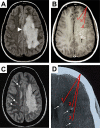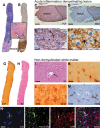Molecular changes in white matter adjacent to an active demyelinating lesion in early multiple sclerosis
- PMID: 19016740
- PMCID: PMC8094783
- DOI: 10.1111/j.1750-3639.2008.00231.x
Molecular changes in white matter adjacent to an active demyelinating lesion in early multiple sclerosis
Abstract
A stereotactic biopsy of a 17-year-old woman revealed an active inflammatory demyelinating lesion compatible with pattern III multiple sclerosis (MS) according to Lucchinetti et al. The biopsy included a white matter region distant from the active inflammatory demyelinating lesion with abnormal MRI signal, lacking histopathological signs of demyelination and/or oligodendrocyte apoptosis. Expression analysis of this area revealed a strong up-regulation of neuronal nitric oxide synthase (nNOS). Furthermore, detection of nitrotyrosine provided evidence for reactive nitrogen species (RNS)-mediated damage to oligodendrocytes. Concomitantly, genes involved in neuroprotection against oxidative stress such as heme oxygenase 1 were up-regulated. Even though a single case report, this study shows earliest molecular changes in white matter surrounding an actively demyelinating lesion during the first manifestation of MS, pointing toward a more widespread pathological process. Therapeutic targeting of the identified mechanisms of tissue injury might be crucial to prevent further lesion formation or secondary tissue damage.
Figures


References
-
- Barnett MH, Prineas JW (2004) Relapsing and remitting multiple sclerosis: pathology of the newly forming lesion. Ann Neurol 55:458–468. - PubMed
-
- Bruck W, Bitsch A, Kolenda H, Bruck Y, Stiefel M, Lassmann H (1997) Inflammatory central nervous system demyelination: correlation of magnetic resonance imaging findings with lesion pathology. Ann Neurol 42:783–793. - PubMed
-
- Cannella B, Raine CS (2004) Multiple sclerosis: cytokine receptors on oligodendrocytes predict innate regulation. Ann Neurol 55:46–57. - PubMed
Publication types
MeSH terms
Substances
LinkOut - more resources
Full Text Sources
Medical

